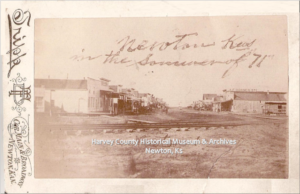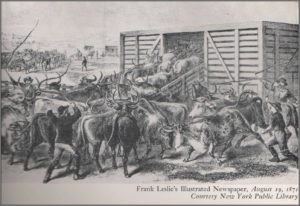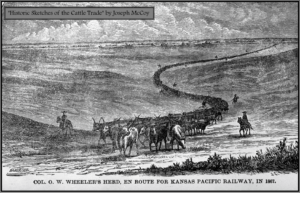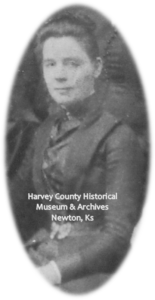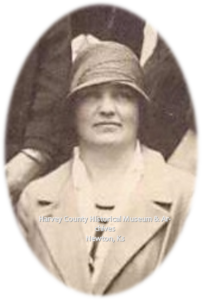by Kristine Schmucker, HCHM Curator
146 years ago . . .
In May 1871, a cow boy traveling through the area took note of the new town on the prairie.
“We crossed Bluff Creek into Kansas and passed Newton during the latter part of May. A blacksmith shop, a store, and a dozen dwelling places made up this town at that time, but when we came back through the place on our return home thirty days later, it had grown to be quite a large town due to the building of the railroad. It did not seem possible that a town could make such a quick growth in such a short time, but Newton, Kansas sprang up almost over night.”
The Atchinson, Topeka & Santa Fe Railroad reached Newton in July. The first passenger train went through on July 17, 1871. Newton’s summer as a cow town began.
The stockyards were located a mile and half west of the town. Built under the supervision of Joseph McCoy, the Newton yards measured 300 x 400 feet, with the capacity to hold up to 4000 head. During that summer, 40,000 head were shipped to markets in the east from Newton, Ks.
Reporters from around the region were at the new cow town throughout the summer of 1871. They describe for their readers in the east the sights and sounds of a rowdy cow town.
A correspondent for the Topeka Commonwealth in Newton wrote on May 30, 1871.
Several thousand head of Texas cattle are now grazing in this vicinity waiting the completion of the road for shipment, and thousands more are coming in everyday: even this minute looking out my west door I can see two large herds entering the town, all waiting to ship from this point.”
A correspondent for the Saline County Journal described the scene on the prairie on July 20, 1871
“The entire country east, west, and south of Salina and down to the Arkansas River is filled with Texas cattle . . . The bottoms are overflowing with them, and the water courses with this great article of traffic . . . And the cry is, “still, they come!”
A reporter for the Dallas Herald noted on July 22, that
“The stream of cattle still pours in. Its line is now continuous from the Rio Grande. If the flow continues, the prairies will be inundated with Texas Longhorns before the close of the season.”
The local homesteaders were less enthusiastic with the influx of Texas longhorns.
Mary Hildreth (Mrs. C.B.) lived on a hill over looking the cattle crossing of Sand Creek. She later shared a story of a day she caused a stampede.
Throughout the summer, she had difficulty with roving cattle that would devour her garden. In frustration, one day she went out on her porch and yelled as loud as she could waving a red table cloth —her actions caused the whole herd to stampede . . . all the way to Abilene.
Cornie R. Royston Reese (Mrs. John C.) also later shared her memory of those early years.
“The cow boys used to drive the cattle to Newton and let them browse along Sand Creek. They would go to the gambling houses and the saloons” in Newton.
F. A. Prouty arrived in Harvey County in late August 1871 at the close of the cattle drive season. The homesteaders worked quickly in preparation for the next summer.
“We worked as fast as possible, stopping our building long enough to put up hay to carry us through the winter, which did not take a large amount as we lost all our cattle with Texas fever shortly after our arrival here. In the spring of 1872, we bought quite a number of wild steers out of a Texas herd. The cow boys would rope the steers and neck them together in pairs, a few days later we would have a yoke on them and have them with our broke cattle helping pull a plow. The sight of a snake or unusual noise would often excite them and they would make an effort to stampeded.”
By 1873, the cattle trade had moved to Wichita and with it many of the problems associated with a cow town.



